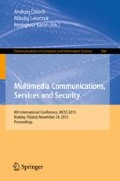Abstract
Over 10 billion hours of video are watched each month on the Internet, what, together with high definition television broadcasting and the rise in high quality video on demand makes the task of quality assessment a key one in the global multimedia market nowadays. Automating quality checking is currently based on finding major audiovisual artifacts. The Monitoring Of Audio Visual quality by key Indicators (MOAVI) subgroup of the Video Quality Experts Group (VQEG) is an open collaborative project for developing No-Reference models for monitoring audiovisual service quality. The purpose of this paper is to report the development of the audiovisual part of this project, which includes the detection of lip synchronization (also known as lip sync) artifacts.
Access this chapter
Tax calculation will be finalised at checkout
Purchases are for personal use only
References
Baran, R., Glowacz, A., Matiolanski, A.: The efficient real- and non-real-time make and model recognition of cars. Multimedia Tools Appl. 74(12), 4269–4288 (2015). http://dx.doi.org/10.1007/s11042-013-1545-2
Cerqueira, E., Janowski, L., Leszczuk, M., Papir, Z., Romaniak, P.: Video artifacts assessment for live mobile streaming applications. In: Mauthe, A., Zeadally, S., Cerqueira, E., Curado, M. (eds.) FMN 2009. LNCS, vol. 5630, pp. 242–247. Springer, Heidelberg (2009)
Farneback, G.: Very high accuracy velocity estimation using orientation tensors, parametric motion and simultaneous segmentation of motion field. In: Proceedings of the Eighth IEEE International Conference on Computer Vision, Vancouver, Canada (2001)
Głowacz, A., Grega, M., Gwiazda, P., Janowski, L., Leszczuk, M., Romaniak, P., Romano, S.: Automated qualitative assessment of multi-modal distortions in digital images based on glz. Ann. Telecommun. - Ann. Telecommun. 65(12), 3–17 (2010). http://dx.doi.org/10.1007/s12243-009-0146-6
Kacprzak, S., Ziółko, M.: Speech/music discrimination via energy density analysis. In: Dediu, A.-H., Martín-Vide, C., Mitkov, R., Truthe, B. (eds.) SLSP 2013. LNCS, vol. 7978, pp. 135–142. Springer, Heidelberg (2013)
Leszczuk, M., Baran, R., Skoczylas, Ł., Rychlik, M., Ślusarczyk, P.: Public transport vehicle detection based on visual information. In: Dziech, A., Czyżewski, A. (eds.) MCSS 2014. CCIS, vol. 429, pp. 16–28. Springer, Heidelberg (2014)
Moddemeijer, R.: On the convergence of the iterative solution of the likelihood equations. In: Schouwhamer Immink, K.A. (ed.) Ninth Symposium on Information Theory in the Benelux, May 26-27, 1988, Mierlo (NL), pp. 121-128. Werkgemeenschap Informatie- en Communicatietheorie, Enschede (NL) (1999). ISBN: 90-71048-04-7
Sohn, J., Sung, W.: A voice activity detector employing soft decision based noise spectrum adaptation. In: Proceedings of the 1998 IEEE International Conference on Acoustics, Speech and Signal Processing, vol. 1, pp. 365–368, May 1998
Staelens, N., De Meulenaere, J., Bleumers, L., Van Wallendael, G., De Cock, J., Geeraert, K., Vercammen, N., Van den Broeck, W., Vermeulen, B., Van de Walle, R., Demeester, P.: Assessing the importance of audio/video synchronization for simultaneous translation of video sequences. Multimedia Syst. 18(6), 445–457 (2012). http://dx.doi.org/10.1007/s00530-012-0262-4
Steinmetz, R.: Human perception of jitter and media synchronization. IEEE J. Sel. Areas Commun. 14(1), 61–72 (1996)
Venkatesh, R., Bopardikar, A.S., Perkis, A., Hillestad, O.I.: No-reference metrics for video streaming applications. In: Proceedings of the 14th International Packet Video Workshop (PV 2004), Irvine, CA, USA, 13–14 December 2004
Viola, P., Jones, M.: Robust real-time object detection. Int. J. Comput. Vis. 57(2), 137–154 (2001)
Acknowledgments
The work was co-financed by The Polish National Centre for Research and Development (NCBR), as a part of the EUREKA Project №. C 2012/1-5 MITSU.
Author information
Authors and Affiliations
Corresponding author
Editor information
Editors and Affiliations
Rights and permissions
Copyright information
© 2015 Springer International Publishing Switzerland
About this paper
Cite this paper
Fernández, I.B., Leszczuk, M. (2015). Detection of Lip Synchronization Artifacts. In: Dziech, A., Leszczuk, M., Baran, R. (eds) Multimedia Communications, Services and Security. MCSS 2015. Communications in Computer and Information Science, vol 566. Springer, Cham. https://doi.org/10.1007/978-3-319-26404-2_2
Download citation
DOI: https://doi.org/10.1007/978-3-319-26404-2_2
Published:
Publisher Name: Springer, Cham
Print ISBN: 978-3-319-26403-5
Online ISBN: 978-3-319-26404-2
eBook Packages: Computer ScienceComputer Science (R0)

